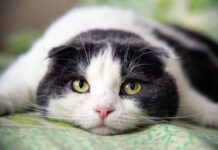Brown Persians and Blindness A genetics study reported in the latest
Not so, say veterinary researchers at the University of California-Davis, noting: “No associations were noted among any of the traits … PRA is not limited to cats with chocolate coat coloration and breeders and veterinarians should be aware that the prevalence of the disease may be higher than currently claimed.”
Good News for Shot-Shy Cats
The latest “American Association of Feline Practitioners Feline Vaccine Advisory Panel Report,” published in the
Journal of the American Veterinary Medical Association (Vol. 229, No. 9), is filled with fine-print technical details for veterinarians and some good news for cats: The so-called multivalent vaccines that protect against several diseases (like those caused by feline panleukopenia virus, feline herpesvirus and feline calicivirus, for example) with a single “shot” and last up to three years are now recommended by the cat-care experts. And the development of vaccines that cause less inflammation at the vaccination site is more good news for cats and for owners who worry about such things.The Feline Practitioners report is
the authoritative source that veterinarians refer to when deciding which vaccines our cats should have and how often. The top cat, so to speak, of the vaccine panel is none other than CatWatchs Dr. James Richards, who heads the Cornell Feline Health Center. The 25,000-word report is the work of 12 experts from the United States, Canada and European Union countries, and its not exactly light reading.But if you insist say you want to know the 10 infectious agents that threaten cats health and what to do about them the full report is available at www.aafponline.org/. We were surprised to learn there is such a thing as kitten socialization classes for novice felines (seven to 14 weeks of age) and their human companions. The panel says kittens should have their first vaccinations at least 10 days before starting class.
But our favorite part is Appendix 6, in which the panel gives veterinarians “Vaccine Administration Tips,” number eight of which reads: “Never approach from the front or make direct eye contact.”
That explains why cats keep looking nervously over their shoulders. And staring.
Top 10 Insurance Claims
From Veterinary Pet Insurance, the company that makes us wish wed bought coverage whenever our favorite feline gets sick, comes this list of Top 10 veterinary medical claims for cats: Number 10 is wound infections, preceded by eye infections, ear infections, diabetes, respiratory infections, skin allergies, kidney disease, stomach upsets and at the top of the heap urinary tract infections.
The number-one claim among dogs, by the way, is skin allergies.
How Fats That Cat?
The journal
Waltham Focus (Vol. 16, No. 1) offers hints to telling the difference between an “obese” cat and one thats merely “overweight.”In a cat of “ideal” weight, the ribcage and spine are not visible but are easily palpable (you can feel them with your hands), while the ideal cat has an obvious abdominal tuck (waist) and little abdominal fat.
An “overweight” cats ribcage and spine are not easily palpable, its waist is “absent” and there is “obvious abdominal distension.”
By comparison, an “obese” cat has massive thoracic, spinal and abdominal fat deposits and “massive abdominal distension,” and the abdominal tuck disappeared several pounds ago (see related article on page 3).
v


